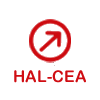Approaches for positioning the active medium in hybrid nanoplasmonics. Focus on plasmon-assisted photopolymerization
Résumé
Over the past 20 years, hybrid plasmonics for nanoemitters of light or for nanoabsorbers, based on weak or strong coupling between metallic nanocavities and active media (emissive or absorbing entities), have given rise to important research efforts. One of the main current challenges is the control +of the nanoscale spatial distribution and associated symmetry of the active medium in the vicinity of the metallic nanoparticles. In this review, we first recall the main principles of weak and strong coupling by stressing the importance of controlling the spatial distribution of the active medium and present the main approaches developed for achieving this control. Nine different approaches are identified. We then focus our attention on one of them based on plasmonic photopolymerization and discuss the flexibility of this approach in terms of control of the spatial symmetry of the hybrid nanosystem metal−polymer nanoemitters and the resulting polarization dependence of the light emission. The different approaches are analyzed and compared with each other, and some future perspectives and challenges are finally discussed.
Domaines
Physique [physics]
Fichier principal
 chen-et-al-2024-approaches-for-positioning-the-active-medium-in-hybrid-nanoplasmonics-focus-on-plasmon-assisted-2.pdf (3.65 Mo)
Télécharger le fichier
chen-et-al-2024-approaches-for-positioning-the-active-medium-in-hybrid-nanoplasmonics-focus-on-plasmon-assisted-2.pdf (3.65 Mo)
Télécharger le fichier
| Origine | Fichiers produits par l'(les) auteur(s) |
|---|


